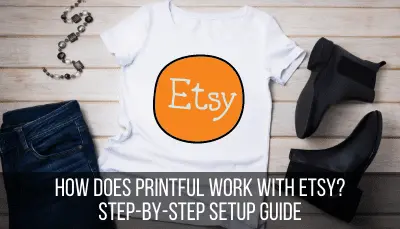Dealing with customer service was my least favorite part of running an Etsy and print on demand (PoD) store. Changed orders, lost packages, and, the worst of all, returns! Returns can be a big pain if you’re a print on demand seller because it’s precious profit out of your pocket, especially if you can’t resell the product again.
When handling print on demand returns, it’s important to prepare ahead of time by having a strong return policy that is clearly stated on your storefront. This will proactively prevent the majority of returns because customers will know what to expect going into the purchase.
Handling returns was, hands down, the most stressful part of running a print on demand store for me.
Overtime, I realized that I needed to get my act together as far as returns were concerned so that I wouldn’t lose my cool. It always was stressful, but I did learn to manage it better.
Packages getting lost in the mail was stressful enough, but that was something I couldn’t control. So, I decided to do something about the thing I could control, which was the way I was handling returns.
The very first thing I did to lower my stress around returns, and gain control, was create a strong return policy.
Before we get into that though, we need to be clear about returns relating to faulty products.
This post may contain affiliate links, which means I may earn a commission if you decide to purchase through my links.
How to Handle Faulty Products in Your Print on Demand Store
If your customer receives a damaged, misprinted, or otherwise faulty product, it’s usually expected that it’s your responsibility as the seller to refund or replace it. Luckily, most print on demand providers will remake any faulty products, free of charge, if the issue was caused by them.
If your customer received a faulty product, this is a different situation than a customer asking for a return because they received a perfectly good product, but decided they didn’t want it anymore.
The good news is that this is easily fixed. If the issue stems from your print provider, most of them will send a replacement to your customer for no charge.
This is why I love Printful and Printify.
Printify’s and Printful’s customer service is great.
Whenever there’s an issue with a product they sent, they will send a replacement to the customer, depending on the situation. To be clear, this usually doesn’t cover packages that have been lost in the mail, so expect to deal with those issues yourself.
Ok, so faulty products don’t count as returns. Let’s dive into actual returns now – those moments when customers receive the product they ordered, but now they don’t want it anymore.
Prevent Print on Demand Returns with a Strong Return Policy
If you have a strong return policy posted in your shop, you can prevent a lot of returns before your customers even think about requesting them. If your customers understand your return policy prior to purchasing, it will encourage them to be more thoughtful about their choices.
In my own store, I had a strong return policy. Unless the item is damaged, misprinted, or otherwise faulty, I didn’t accept returns.
I didn’t always follow this strict policy 100%, but we’ll talk about that later.
In our Amazon-obsessed culture, there’s a tendency to purchase items carelessly because they can be easily returned. And, returns are great! I wish that my PoD store could handle them at the magnitude that Amazon does.
But, it’s just wasn’t realistic for my small PoD store. I couldn’t handle the impact of someone ordering 3 different sizes of the same shirt so that they could try them all on and return the 2 that don’t fit.
So, I told my customers that returns weren’t possible. As a result, I would get a lot more questions from customers about sizing and fit, which I would happily answer. This was a sign that my customers were taking their purchase seriously and doing the work ahead of time to make sure they purchased the right product.
Important note: I realize that I probably lost out on sales because I didn’t have a generous return policy. If a customer was deciding between my store and another store that allowed returns, they’ll probably go with the other store.
But, I was ok with that. I personally would have rather lose a few sales than deal with the inventory and profit loss issues that come with allowing returns.
Now, you may be hesitant to have a policy as strong as mine was. I get that. Here are some things you’ll want to consider when writing your own shop’s return policy.
Have a No Returns Policy that You Break Every Once in a While
Even though I had a no returns policy, I accepted returns for my print on demand products every once in a while. If I believed I could resell the item, if I haven’t had a lot of return requests recently, or a customer was gracious about it, I would usually honor a return.
Being a seller is about being human. At the end of the day, we want our customers to have good experiences with our shop and we don’t want to seem like stone-cold robots that only care about profits.
I found that my no return policy staves off 99% of return requests. Once I implemented it, it became VERY rare for me to get a message from a customer asking for a return. So, I began honoring these very few requests.
Usually, the customers read my return policy and were very gracious in asking for an exception. As we all know as sellers, kindness can go a long way.
Now, you may be thinking that making exceptions like this brings back all of the stress of handling print on demand returns. But, au contraire, this approach makes returns SO much less stressful.
Here’s why.
When you have a no returns policy, your return requests usually drop. Less stress – check.
When you do get a return request, your customer will know that you have a no returns policy and that they are asking you to do them a favor. When you do end up granting them the return, they see it as a kind gesture on your part.
This boosts rapport between you and the customer and makes it more likely they will have a positive experience. Less stress – check.
By having a no return policy, yet granting returns here and there as a kind gesture, you’re flipping the playbook. If you allowed returns, accepting a return would be mundane and expected.
By granting a return when you have a no returns policy, you’re going out of your way to bypass your policy and make life easier for your customer, which they end up being appreciative for.
It not only helps your store, but it also does wonders for the amount of stress you feel when handling returns.
Ok, so whether you decide to go with a strong return policy for your print on demand store or not, there are some very important things you’ll want to consider.
Base Your Print on Demand Store’s Return Policy on the Types of Products You Sell
If your print on demand products are specifically customized to each customer, you may want to consider having a stronger return policy than your other print on demand products that are more generic and can be resold in the future.
If you have products in your store that are fully customizable (someone’s name, picture, etc), you may decide that you want to have a strong, no returns rule – no exceptions.
Once a product is customized to your customer’s wishes, it can’t be resold. Luckily, a lot of customers already understand that and don’t expect to be able to return their customized items.
On the other hand, if someone wants to return one of your more generic products, you might be able to resell it, especially if it’s one of your popular products.
Think about the types of products you sell and if they are capable of being resold. If they are, you may decide to have more flexibility with your return policy.
If you do decide to allow returns, don’t forget about shipping costs.
Decide Who Will Pay for Return Shipping for Your Print on Demand Products
If you accept returns in your print on demand shop, decide whether or not you’ll have the customer cover the shipping costs to send it back to you. This is something you’ll need to make very clear in your return policy and/or when you communicate with a customer about a return.
If you do end up accepting returns, or even if you only accept a return every once in a while, you need to think about shipping costs.
Mail is not cheap these days. By accepting a return, you’re already out the cost of the product and any profit you made on the sale. If you cover shipping for your returns as well, you’ll really be in the red.
When I accepted returns, I had customers cover the shipping back to me, which usually wasn’t an issue.
Once You’ve Decided on Your Return Policy, Write a Script
When you’ve finalized your return policy, write it down and post it everywhere in your shop so your customers see it multiple times before purchasing. Also write down a predetermined script you send to your customers when they message you about returns.
As soon as you’ve decided on your return policy, write it down and make sure you catch every detail.
Next, post it everywhere in your shop. Put it in the announcements section of your shop, within each listing, in your shop’s description, and in the message that you send your customers to confirm their orders.
Also, write preformulated scripts that you can send your customers if they ask you about returns. If you do accept returns, make sure that this script covers everything the customer needs to know about shipping costs, refunds, and more.
If you don’t accept returns, make sure this script explains why. Do your best to be nice, while also firm.
By having these scripts, you don’t have to worry about making decisions and writing your response for every single customer that reaches out to you.
This will not only save you a lot of time, but also a lot of mental energy that you could be spending on making your store awesome.
Handling returns in your print on demand store is never fun. But, with the right systems in place, it can be a lot less stressful than it seems. Spend some time planning everything out and you’ll save yourself a world of headache, whether you decide to accept returns or not.

Diana has been an artist for over 27 years and has training in drawing, painting, digital drawing and graphic design. Diana’s latest obsession is digitally drawing with Procreate and Procreate Dreams. Diana has experience selling her art across a number of platforms and loves helping other artists learn how to make money from their art as well.



